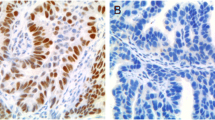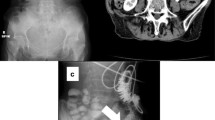Abstract
The aim of this study was to analyze the concentration of anti-p53 antibodies in the serum of breast cancer patients and to correlate these results with various clinical, pathological and biochemical parameters. We also wanted to assess the prognostic significance of these antibodies in our patients. Sera from 61 patients with breast cancer and 20 individuals without malignancies were analyzed using enzyme-linked immunoadsorbent assay. High levels of anti-p53 antibodies were detected in twenty-one (35%) breast cancer patients and one control (5%). The difference was statistically significant. We observed an inverse relationship between the anti-p53 antibodies and the age of the patients. We found significant association of anti-p53 antibodies with tumor size, histological grade of the tumors and the number of axillary lymph nodes involved. The levels of anti-p53 antibodies were higher in patients with negative estrogen and progesterone receptors in comparison with patients with positive steroid receptors, but the difference was not statistically significant. No relation was observed between anti-p53 antibodies neither with the Cathepsin D levels in the cytosol nor with the HER-2/neu extracellular domain in the serum. Patients with primary tumors and higher levels of anti-p53 antibodies had shorter 5-year survival than patients with lower levels of anti-p53 antibodies. Our results support the role of anti-p53 antibodies as a biomarker of less favorable phenotype as well as a prognostic factor for patients with breast cancer.






Similar content being viewed by others
References
Finlay CA, Hinds PW, Levine AJ. The p53 proto-oncogene can act as a suppressor of transformation. Cell. 1989;57:1083–93.
Eliyahu D, Michalovitz D, Eliyahu S, Pinhasi-Kimhi O, Oren M. Wild-type p53 can inhibit oncogene-mediated focus formation. Proc Natl Acad Sci USA. 1989;86:8763–7.
Hollstein M, Sidransky D, Vogelstein B, Harris CC. p53 mutations in human cancer. Science. 1991;253:49–53.
Borresen-Dale AL. TP53 and breast cancer. Hum Mutat. 2003;21:292–300.
Vogelstein B, Lane D, Levine AJ. Surfing the p53 network. Nature. 2000;408:307–10.
Lane DP. p53, guardian of the genome. Nature. 1992;358:15–6.
Levine AJ. p53, the cellular gatekeeper for growth and division. Cell. 1997;88:323–31.
Dameron KM, Volpert OV, Tainsky MA, Bouck N. Control of angiogenesis in fibroblasts by p53 regulation of thrombospondin-1. Science. 1994;265:1582–4.
Hanahan D, Weinberg RA. The hallmarks of cancer. Cell. 2000;100:57–70.
Davidoff AM, Humphrey PA, Iglehart JD, Marks JR. Genetic basis for p53 overexpression in human breast cancer. Proc Natl Acad Sci USA. 1991;88:5006–10.
Balogh GA, et al. Mutant p53 protein in serum could be used as a molecular marker in human breast cancer. Int J Oncol. 2006;28(4):995–1002.
Angelopoulou K, et al. Prevalence of serum antibodies against the p53 tumor suppressor gene protein in various cancer. Int J Cancer. 1994;58:480–7.
Lubin R, et al. p53 antibodies in patients with various types of cancer: assay, identification, and characterization. Clin Cancer Res. 1995;1:1463–9.
Soussi T. p53 antibodies in the sera of patients with various types of cancer: a review. Cancer Res. 2000;60:1777–88.
Shimada H, Ochiai T, Nomura F. Titration of serum p53 antibodies in 1085 patients with various types of malignant tumors. Cancer. 2003;97:682–9.
Fonseca RF, et al. Anti-p53 antibodies in Brazilian brain tumor patients. Genet Mol Res. 2003;2:185–90.
Bray F, McCarron P, Parkin DM. The changing global patterns of female breast cancer incidence and mortality. Breast Cancer Res. 2004;6:229–39.
Ferlay J, Autier M, Boniol M, Heanue M, Boyle CP. Estimates of the cancer incidence and mortality in Europe in 2006. Ann Oncol. 2007;18:581–92.
Znaor A. Breast cancer in Croatia-where are we now and what do we expect [in Croatian]. HCJZ 2008; 4: January 7, Available at: http://www.hcjz.hr/clanak.php?id=13572.
Croatian Health Service, Cancer Registry: cancer incidence in Croatia in 2006 [in Croatian]. Bulletin no.31, Available at: http://www.hzjz.hr/rak/novo.htm.
Bloom HJ, Richardson WW. Histological grading and prognosis in breast cancer: a study of 1409 cases of which 359 have been followed for 15 years. Br J Cancer. 1957;11:359–77.
Romić-Stojković R, Gamulin S. Relationship of cytoplasmic and nuclear estrogen and progesteron receptor in human breast cancer. Cancer Res. 1980;40:4821–5.
Crawford LV, Pim DC, Bulbrook RD. Detection of antibodies against the cellular protein p53 in sera from patients with breast cancer. Int J Cancer. 1982;30:403–8.
Vojtesek B, et al. Absence of p53 autoantibodies in a significant proportion of breast cancer patients. Br J Cancer. 1995;71:1253–6.
Peyrat JP, et al. Prognostic significance of circulating p53 antibodies in patients undergoing surgery for locoregional breast cancer. Lancet. 1995;345:621–2.
Gao RJ, et al. The presence of serum anti-p53 antibodies from patients with invasive ductal carcinoma of breast: correlation to other clinical and biological parameter. Breast Cancer Res Treat. 2005;93:111–5.
Mudenda B, et al. The relationship between serum p53 autoantibodies and characteristics of human breast cancer. Br J Cancer. 1994;69:1115–9.
Müller M, et al. Testing for anti-p53 antibodies increases the diagnostic sensitivity of conventional tumor markers. Int J Oncol. 2006;29:973–80.
Regele S, Vogl FD, Kohler T, Kreienberg R, Runnebaum IB. p53 autoantibodies can be indicative of the development of breast cancer relapse. Anticancer Res. 2003;23:761–4.
Wilsher PC, et al. The significance of p53 autoantibodies in the serum of patients with breast cancer. Anticancer Res. 1996;16:927–30.
Davidoff AM, Iglehart JD, Marks JR. Immune response to p53 is dependent upon p53/HSP70 complexes in breast cancers. Proc Natl Acad Sci USA. 1992;89:3439–42.
Lutz W, Nowakowska-Swirta E. Gene p53 mutations, protein p53, and anti-p53 antibodies as biomarkers of cancer process. Int J Occup Med Environ Health. 2002;15:209–18.
Labrecque S, Naor N, Thomson D, Matlashewski G. Analysis of the anti-p53 antibody response in cancer patients. Cancer Res. 1993;53:3468–71.
Winter SF, et al. Development of antibodies against p53 in lung cancer patients appears to be dependent on the type of p53 mutation. Cancer Res. 1992;52:4168–74.
Sangrajrang S, et al. Serum p53 antibodies in correlation to other biological parameters of breast cancer. Cancer Detect Prev. 2003;27:182–6.
Regidor PA, Regidor M, Callies R, Schindler AE. Detection of p53 auto-antibodies in the sera of breast cancer patients with a new recurrence using an ELISA assay. Does a correlation with the recurrence free interval exist. Eur J Gynaecol Oncol. 1996;17:192–9.
Schlichtholz B, et al. The immune response to p53 in breast cancer patients is directed against immunodominant epitopes unrelated to the mutational hot spot. Cancer Res. 1992;52:6380–4.
Foekens JA, et al. Cathepsin-D in primary breast cancer: prognostic evaluation involving 2810 patients. Br J Cancer. 1999;79:300–7.
Tetu B, et al. Cathepsin D expression by cancer and stromal cells in breast cancer: an immunohistochemical study of 1348 cases. Breast Cancer Res Treat. 1999;55:137–47.
Zheng WQ, Looi LM, Cheah PL. Correlation between laminin and cathepsin D expression in breast carcinoma. Tumori. 2002;88:296–9.
Harris L, et al. American society of clinical oncology 2007 update recommendations for the use of tumor markers in breast cancer. J Clin Oncol. 2007;25:5287–312.
Berns EM, et al. Complete sequencing of TP53 predicts poor response to systemic therapy of advanced breast cancer. Cancer Res. 2000;60:2155–62.
Chappius PO, et al. Prognostic significance of p53 mutation in breast cancer frequent detection of non-missense mutations by yeast functional assay. Int J Cancer. 1999;84:587–93.
Agrawal AK, et al. Molecular markers (c-erbB2, p53) in breast cancer. Folia Histochem Cytobiol. 2008;46:449–55.
Hammel P, et al. Detection and monitoring of serum p53 antibodies in patients with colorectal cancer. Gut. 1997;40:356–61.
Lenner P, et al. Serum antibodies against p53 in relation to cancer risk and prognosis in breast cancer: a population-based epidemiological study. Br J Cancer. 1999;79:927–32.
Porzolt F, Schmid M, Hoher D, Muche R, Gaus W, Montenarh M. Biologic relevance of auto-antibodies against p53 in patients with metastatic breast cancer. Onkologie. 1994;17:402–8.
Bao H, et al. Predictive value of serum ant-p53 antibodies, carcino-embryonic antigen, carbohydrate antigen 15–3, estrogen receptor, progesterone receptor and human epidermal growth factor receptor-2 in taxane-based and anthracycline-based neoadjuvant chemotherapy in locally advanced breast cancer patients. Anticancer Drugs. 2008;19:317–23.
Author information
Authors and Affiliations
Corresponding author
Rights and permissions
About this article
Cite this article
Kulić, A., Sirotković-Skerlev, M., Jelisavac-Ćosić, S. et al. Anti-p53 antibodies in serum: relationship to tumor biology and prognosis of breast cancer patients. Med Oncol 27, 887–893 (2010). https://doi.org/10.1007/s12032-009-9301-1
Received:
Accepted:
Published:
Issue Date:
DOI: https://doi.org/10.1007/s12032-009-9301-1




